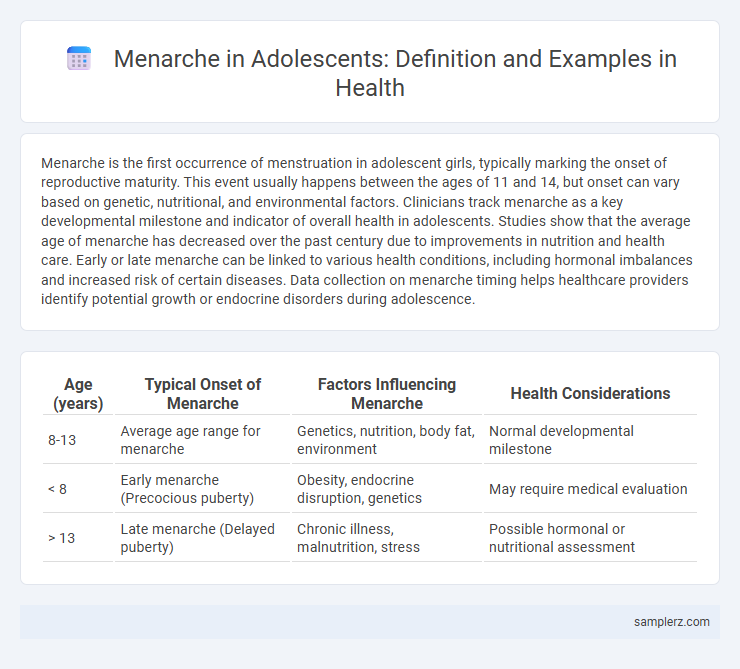Menarche is the first occurrence of menstruation in adolescent girls, typically marking the onset of reproductive maturity. This event usually happens between the ages of 11 and 14, but onset can vary based on genetic, nutritional, and environmental factors. Clinicians track menarche as a key developmental milestone and indicator of overall health in adolescents. Studies show that the average age of menarche has decreased over the past century due to improvements in nutrition and health care. Early or late menarche can be linked to various health conditions, including hormonal imbalances and increased risk of certain diseases. Data collection on menarche timing helps healthcare providers identify potential growth or endocrine disorders during adolescence.
Table of Comparison
| Age (years) | Typical Onset of Menarche | Factors Influencing Menarche | Health Considerations |
|---|---|---|---|
| 8-13 | Average age range for menarche | Genetics, nutrition, body fat, environment | Normal developmental milestone |
| < 8 | Early menarche (Precocious puberty) | Obesity, endocrine disruption, genetics | May require medical evaluation |
| > 13 | Late menarche (Delayed puberty) | Chronic illness, malnutrition, stress | Possible hormonal or nutritional assessment |
Understanding Menarche: A Key Milestone in Adolescent Health
Menarche, the first menstrual cycle in adolescent girls, typically occurs between ages 12 and 13, marking a critical developmental milestone in reproductive health. This event signifies the onset of ovulatory cycles, essential for fertility and hormonal balance, and is influenced by genetics, nutrition, and overall health. Monitoring menarche timing provides valuable insights into adolescent growth patterns and can help identify potential endocrine or nutritional disorders.
Common Signs and Symptoms of Menarche in Teenagers
Menarche in adolescents typically presents with common signs such as the onset of menstrual bleeding, abdominal cramping, and breast tenderness. Other symptoms frequently observed include mood swings, bloating, and occasional headaches due to hormonal fluctuations. Recognizing these indicators helps in understanding the physical and emotional changes during puberty.
Average Age and Variability of Menarche Onset
The average age of menarche in adolescent girls typically ranges between 12 and 13 years, with significant variability influenced by genetics, nutrition, and environmental factors. Studies indicate onset can occur as early as 8 years or as late as 16 years, reflecting diverse developmental timelines. Monitoring this variability is essential for assessing normal growth patterns and identifying potential health concerns.
Physical and Emotional Changes During Menarche
Menarche marks the onset of menstruation in adolescent girls, triggering significant physical changes such as breast development, growth spurts, and the start of ovulation cycles. Emotional fluctuations often accompany menarche, including mood swings, increased sensitivity, and heightened anxiety due to hormonal shifts. Understanding these physical and emotional changes is crucial for providing appropriate support during this key developmental phase.
Factors Influencing the Timing of Menarche in Adolescents
Genetic predisposition, nutritional status, and overall health significantly influence the timing of menarche in adolescents. Higher body mass index (BMI) and adequate intake of essential nutrients, such as iron and vitamin D, are associated with earlier onset of menstruation. Environmental factors, including exposure to endocrine-disrupting chemicals and chronic stress, can also alter the physiological timeline of menarche.
Menarche and Nutritional Status: A Correlated Overview
Menarche, the onset of the first menstrual period in adolescent girls, is closely linked to nutritional status, with adequate body fat and nutrient availability playing critical roles in its timing. Studies show that undernutrition or eating disorders often delay menarche, while improved nutritional intake and higher body mass index (BMI) contribute to earlier onset. Monitoring adolescent nutrition is essential for understanding menstrual health and preventing associated reproductive and metabolic disorders.
Cultural Perspectives on Menarche in Adolescent Girls
Cultural perspectives on menarche in adolescent girls significantly influence how this developmental milestone is perceived and managed across different societies. In many cultures, menarche is marked by traditional rituals and celebrations that emphasize the transition from childhood to womanhood, shaping social identity and familial expectations. These practices impact the psychological well-being and menstrual health education of adolescents, highlighting the need for culturally sensitive health interventions.
Menarche Education: Preparing Adolescents for Their First Period
Menarche education plays a crucial role in preparing adolescents for their first period by providing accurate information about menstrual hygiene, hormonal changes, and emotional well-being. Effective programs include detailed explanations of the menstrual cycle, use of sanitary products, and managing common symptoms like cramps and mood swings. Educators and healthcare providers emphasize creating a supportive environment that promotes confidence and reduces anxiety associated with menarche.
Addressing Myths and Misconceptions About Menarche
Menarche, the first menstrual period in adolescent girls, is often surrounded by myths such as it being a sign of illness or an immediate need to restrict physical activity. Scientific evidence confirms that menarche is a natural developmental milestone marking reproductive maturity and does not necessitate medical intervention unless irregularities occur. Educating adolescents and caregivers about the biological processes and normal variations of menarche helps dispel misconceptions and promotes healthy attitudes towards menstruation.
Supporting Adolescent Well-being During Menarche Transition
Menarche, the onset of the first menstrual period, typically occurs between ages 10 and 15, marking a critical phase in adolescent development and reproductive health. Supporting adolescent well-being during this transition involves comprehensive education about menstrual hygiene, emotional support to address body image and mood fluctuations, and access to healthcare resources. Creating a supportive environment at home and school enhances self-esteem and promotes healthy coping strategies during this significant physiological change.

example of menarche in adolescent Infographic
 samplerz.com
samplerz.com